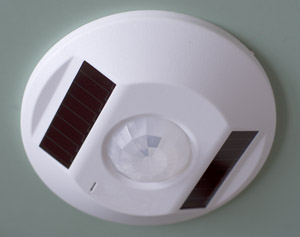The National Lighting Product Information Program (NLPIP) at Rensselaer Polytechnic Institute’s Lighting Research Center (LRC) recently released its latest publication, Lighting Answers: Comparison of Wired and Wireless Lighting Controls for Single Rooms.
The report details findings from NLPIP’s study of wireless occupancy sensors and photosensors, focusing on control systems designed for a single room in a commercial building such as an office, classroom, or conference room. The investigation included occupancy sensor and photosensor features and performance, wireless communication performance, compatibility with lighting products, energy harvesting and storage capabilities, and capital costs of control systems.
 |
|
Wireless lighting control. (Photo courtesy of Rensselaer Polytechnic Institute’s Lighting Research Center (LRC)) |
Key findings include:
-
Wireless occupancy sensors from the evaluated brands were available with only passive infrared detection technology. The lack of wireless ultrasonic and dual technology occupancy detectors should be taken into consideration where furniture may block motion detection.
-
The wireless occupancy sensors and photosensors tested had similar performance as equivalent wired sensors from the same manufacturer.
-
The wireless communication was robust in a typical office environment.
-
For controllers that don’t make use of a neutral wire and/or are installed in a switchbox without a neutral wire, operation could be an issue for lighting with electronic ballasts or drivers, so verification is needed.
-
Photovoltaic energy harvesting by the tested occupancy sensors is likely to be insufficient at some ceiling locations. Installing a battery in the sensor will circumvent this problem.
-
The tested wireless occupancy sensor systems had 54 to 128% higher capital costs than the equivalent wired systems from the same brand.
The report was sponsored by the Connecticut Energy Efficiency Fund and Natural Resources Canada.
Lighting Answers: Comparison of Wired and Wireless Lighting Controls for Single Rooms is available free to the public, courtesy of the above sponsors, at: http://www.lrc.rpi.edu/nlpip/publicationDetails.asp?id=944&type=2.





 CN
TW
EN
CN
TW
EN






